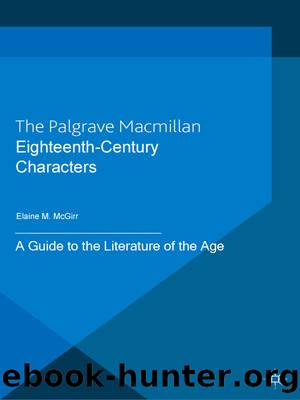Eighteenth-Century Characters by E. Mcgirr

Author:E. Mcgirr
Language: eng
Format: epub
Publisher: Macmillan Education UK
Published: 2007-03-14T16:00:00+00:00
La. Grace.
And yet both of them do it for the same vain Ends; to establish a false Character of being Virtuous.
(III.143â9)
The coquette and the prude maintain a sexual innocence in order to sin with impunity elsewhere. In other words, the prudeâs frigidity and the coquetteâs refusal to commit to any one man far or long enough to move from the âspeculativeâ to the âpracticâ part of love are carefully calculated strategies rather than evidence of their ânaturalâ feminine modesty. They remain chaste not because they are so, but only so that they might claim greater pleasures, particularly the pleasures of gossip and the ability to control and dictate conversation. In Cibberâs plays, the coquette and the prude are looking for social power and authority, not love.
Lady Graceâs comment reminds us of the playâs corrective lesson: that female virtue is not synonymous with sexual continence. The coquette and the prude have false characters for virtue, for their habits of gossip, back-biting, and slandering are hardly virtuous. But Lady Grace is also suggesting that the coquette and the prude are not virtuous in the more traditional sense of chastity. She reminds us that both characters are defined by their sexuality and their relation to men. The coquette cannot be truly virtuous as she uses her âcharmsâ to toy with men and court their attentions, behaviour which, we are often reminded, often ends in seduction or rape. The prudeâs assumption that her virginity is constantly in danger suggests that she is equally aware of her charms and their potential effect on men â the prude protests too much for her aversion to men to be believed. The punning on âvainâ in Lady Graceâs response highlights the other great sin of the coquette and the prude: vanity, the characteristic furthest from the good womanâs defining modesty. Their innate vanity also means that the coquette and the prude assume these characters to give them social importance they would otherwise not possess. Like the woman who adopts the hoop petticoat for fear she should âappear little in the Eyes of all her Acquaintanceâ (T116), the liberties obtained under the character of either the coquette or the prude allow her to âlook big.â But because these characters are so unnatural, this effort will always be in vain: neither the coquette nor the prude âlook bigâ to Lady Grace or Manly. They even fail to appear virtuous.
Manlyâs view of the coquette and the prude is even more interesting. Far from finding the coquetteâs flirtations attractive, he accuses her of âplaguingâ the men â of assuming a place and an importance in conversation that she does not merit. Both the coquette and the prude take unlicensed freedoms in conversation, freedoms that decrease their attractiveness to men while they increase their own pleasures. Both characters keep their âfalse charactersâ only so that they may attack their chosen prey â men for coquettes and other women for the prudes â with more impunity. So while Steeleâs coquette and prude assume their
Download
This site does not store any files on its server. We only index and link to content provided by other sites. Please contact the content providers to delete copyright contents if any and email us, we'll remove relevant links or contents immediately.
The Power of Myth by Joseph Campbell & Bill Moyers(1001)
Half Moon Bay by Jonathan Kellerman & Jesse Kellerman(952)
A Social History of the Media by Peter Burke & Peter Burke(935)
Inseparable by Emma Donoghue(921)
The Nets of Modernism: Henry James, Virginia Woolf, James Joyce, and Sigmund Freud by Maud Ellmann(833)
The Spike by Mark Humphries;(764)
The Complete Correspondence 1928-1940 by Theodor W. Adorno & Walter Benjamin(746)
A Theory of Narrative Drawing by Simon Grennan(742)
Culture by Terry Eagleton(713)
Ideology by Eagleton Terry;(696)
Bodies from the Library 3 by Tony Medawar(680)
Farnsworth's Classical English Rhetoric by Ward Farnsworth(673)
World Philology by(673)
Game of Thrones and Philosophy by William Irwin(669)
High Albania by M. Edith Durham(654)
Adam Smith by Jonathan Conlin(648)
A Reader’s Companion to J. D. Salinger’s The Catcher in the Rye by Peter Beidler(646)
Comic Genius: Portraits of Funny People by(616)
Monkey King by Wu Cheng'en(609)
